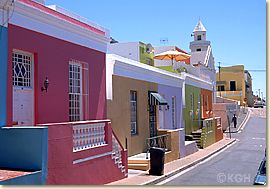Bo Kaap or Cape Malay Quarter
The next day we take a minibus for 3 rand each (10 rand to a dollar) to look for an apartment. The buses are many and frequent with no schedule-you just wave one down when you need it-very efficient!

As we walk into the neighborhood where we have found a beautiful modern apartment, de Waterkant Village, in a quiet residential area near downtown, I see a young guy in red plastic tennis shoes with a funky white patent plastic shoulder bag with Catch 22 written on it it cross the street and I know which Cape Town neighborhood we are in…do you? The neighorhood, used to be Malay, a (colored) neighborhood until all the Malays were run out by the apartheid system. Now it has become a gentrified little village with little cafes although some Malays are moving back in. This is the gay neighborhood.
The “Bo Kaap” or “Cape Malay Quarter” belongs to the culturally and historically most interesting parts of Cape Town. Many of the inhabitants are decendants of the people from Indonesia (Batavia), Sri Lanka, India and Malaysia, who were captured in the 17th and 18th century and enslaved by the Dutch-East Indian Trading Company. Many were Mulims and others were converted to Islam by the Cape Muslim community.
The Cape Malays and their religious leaders played an important role in the development of the language and culture of the Cape colony. The Afrikaans language evolved as a language of its own through a simplification of Dutch in order for the slaves to be able to communicate with the Dutch and amongst each others, since they all came from different countries and cultures. Educated Muslims were the first to write texts in Afrikaans.
The Cape Malays have preserved their cultural identity and Muslemic creed. The old Malay Quarter with its steep and narrow streets, the plain artisan houses, Mosques and Minaretts reaches from the Buitengracht street up to the Signal Hill. The houses were restored and colourfully painted. The architectural style is a synthesis of Cape Dutch and Edwardian.
One of the oldest buildings in Wale Street 71 houses the “Bo-Kaap Museum”. It is furnished as a Muslim house of the 19th century and documents the history of the Cape Malays.
Coon Carnival
Around the corner from our apartment was a little muslim owned market we would go to every morning for a pastry and the newspaper. One morning I asked the shopkeeper who all the people were who would come at night to sing those wonderful rhythmic songs in the big empty garage across the street. He tried to explain to me about the “coons.” When I looked at him with a quizzical look he said, oh, yes, in the United States coon is a bad word isn’t it?
But later, when we visited the District 6 museum we learned about the Coon Carnival that takes place every year at New Years. They practice all year long, three times a week, for the new years carnival where groups from all over compete in singing contests. They parade through the center of Cape Town wearing their coon uniforms and black and white cream on their faces. No one ever did explain why the participants are called “coons.”
It was originally introduced by the Muslim slaves who celebrated their only day off work in the whole year. Nowadays men, woman and children march from the Grand Parade to the Green Point stadium, singing and dancing. They are clad in colorful, shiny suits, white hats and carry a sun umbrella.
The next leg of our journey is supposed to be India but since the state department has asked all Americans to leave India because of the Kashmir/Pakistani conflict I don’t know what we are going to do. We have four weeks here to decide but we will probably go. Right now I don’t want to think of going ANYWHERE!
Tags: Best Places, Cape Malay, Hostels & Guesthouses, Hotels, Hotels,Hostels & Guesthouses, India, South Africa


Leave a Reply